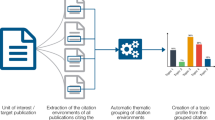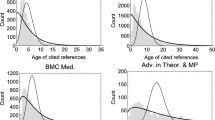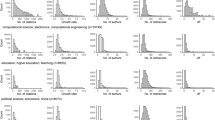Conclusions
The Markov Chains model was applied on a sample of citation data to predict the shifting trends of scientific inquiry from science and technology to social science subjects [7]. The validity of the findings awaits verification by future data. The same technique has recently been utilized to predict the movements of authors among nine subtopics in ethnomusicology [11]. Although a validation was attempted, unfortunately, inadequate data rendered the comparison inconclusive. In the present study, publications from the 1961–1970 Index were used to model the process of subfield shifts in a physics journal. It was assumed that authors movements among subfields of physics as shown in the subject headings assigned would reflect the subject shifts of the journal. The rate of change between the initial probability distribution and the limiting probability distribution were used to predict developmental trends. Finally, the subject distribution of publications appearing in the next ten-year Index validated the prediction. It is reasonable to conclude that the Markov Chains model appears to predict the shifts of research trends in a specialty journal.
Similar content being viewed by others
References
Vlachý J.: Scientometrics1 (1979) 201–208.
Vlachý J.: Czech. J. Phys.B 31 (1981) 669–674.
Vlachý J.: Czech. J. Phys.B 31 (1981) 675–686.
le Pair C.: Scientometrics2 (1980) 177–191.
van Houten J., van Vuren H. G., le Pair C., Dijkhuis G.: Scientometrics5 (1983) 257–267.
Ebeling W., Schamhorst A.: Czech. J. Phys.B 36 (1986) 43–46.
Zunde P., Slamecka V.: Inform. Stor. & Retr.7 (1971) 103–109.
Goffman W.: J. ACM18 (1971) 173–185.
Geller N. L.: Inform. Process. Manag.14 (1978) 93–95.
Goffman W., Warren K. S.: Scientific Information Systems & the Principle of Selectivity. Praeger Press, New York, 1980.
Pao M. L., McCreery L.: Inform. Process. Manag.21 (1985).
Vlachý J.: Czech. J. Phys.B 22 (1972) 336–338.
van Heeringen A., Dijkwel P. A.: Czech. J. Phys.B 36 (1986) 58–61.
Author information
Authors and Affiliations
Additional information
This publication was supported in part by NIH Grants RO 1-LM-04177 and KO 4-LM-00078 from the National Library of Medicine.
Rights and permissions
About this article
Cite this article
Pao, M.L., McCreery, L. Markov Chains theory in the detection of research activities in physics. Czech J Phys 36, 111–114 (1986). https://doi.org/10.1007/BF01599740
Received:
Issue Date:
DOI: https://doi.org/10.1007/BF01599740




